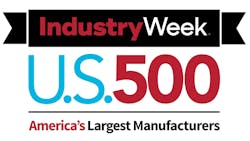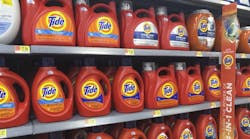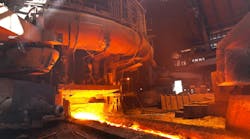Manufacturing Revenues, Profits Plunge: 2025 IndustryWeek U.S. 500
What You'll Learn:
- 2024 was a rough year for the largest manufacturers in the United States
- A handful of very large companies posted massive losses and dragged down the entire industry
- Take out the results of a few massively bad outliers, and the performance looks a lot better
- Scroll to the bottom of the page for the full list
It’s not as bad as it looks.
The results appeared bad, really bad for some industries, but the 2025 IndustryWeek U.S. 500 list of the largest publicly held manufacturing companies in the country is heavily skewed by a handful of special cases.
Results reflect corporate performance for 2024, and I’m not arguing that last year was a great one for manufacturing, but it was better than the index numbers would apply. With those warnings, let’s get the numbers out of the way.
- Revenues: $6.37 trillion, up 0.86% from 2023
- Net income: $496 billion, down 12.8% from 2023
- Johnson & Johnson: $14 billion in 2024 profits vs. $35 billion in 2023, a $21 billion decline
- Intel Corp.: $18.8 billion in 2024 losses vs. $1.7 billion in 2023 profits, a $20.4 billion plunge
- Bristol Myers Squibb Co.: $8.9 billion in 2024 losses vs. $8 billion in 2023 profits, a $17 billion swing
- Emerson Electric Co.: About $2 billion in 2024 profits vs. $13.2 billion a year earlier, an $11.3 billion drop
- The Boeing Co.: $11.8 billion in 2024 losses vs. $2.2 billion in 2023 losses, a $9.6 billion decline
In most of those cases, the massive declines don’t reflect worsening performance so much as technical changes. You can read more about those five special cases in this story’s sidebar.
How We Pick the IW U.S. 500
Data analytics can only take you so far. Sometimes, you need old-fashioned human intelligence. For the second consecutive year, IndustryWeek has taken a labor-intensive approach to determine which companies to include and exclude from our tally of the largest publicly traded U.S. manufacturing companies.
First, we use S&P data to sort companies by who claims to be a manufacturer using industry codes and other self-reported metrics. Then, we sort the top 1,000 or so companies based on their most recent annual revenues (for most companies, 2024, but some oddballs are already done with fiscal 2025). After that, the human sorting begins.
We separate the list into six pieces and hand each one to an IndustryWeek editor to research. Going through annual reports and other financial reports, we look for key phrases such as “rely on manufacturing partners” for many consumer products companies or “fabless” techniques for chip makers. We eliminate companies that outsource production, such as Apple, Nvidia, Nike and even a handful of food companies. What remains are companies that make most or all of their own products.
Taking out some of the big outliers, 2024’s results were very mildly positive. More than half of companies (55%) had higher sales last year than in 2023, and 53% had higher profits. As noted above, sales for the overall group grew slightly. That increase came mainly from raising prices on goods, but some industries had higher volumes of sales as well.
Industrial Companies Post Profit Gains*
- Sales: $1.3 trillion, up 2.6%
- Earnings: $109 billion, down 0.9%
That asterisk is doing a lot of heavy lifting because to see the silver lining in this cloud, you have to exclude Boeing and Emerson Electric, two of the five biggest losers in earnings last year. Without those two companies, sales were up 3.5% for the remaining 148 companies, and earnings jumped 20%. Effectively, losses at Boeing and Emerson wiped out a solid performance from the entire industrials sector.
3M Corp. posted a $4.2 billion profit last year after having lost nearly $7 billion in 2023. Carrier Global’s profits more than tripled, Cummins Inc. was up more than 5x and Northrop Grumman more than doubled profits. Put another way, 100 of the 150 companies in the industrials sector had higher profits in 2024 than in 2023.
Oil and Gas Declines Continue
Sales: $1.2 trillion, down 2.7% Earnings: $76 billion, down 28.9%
For the 2023 IW U.S. 500 list of manufacturers, declines in oil prices dramatically lowered sales and profitability in the energy sector. That trend continued in 2024, but very unevenly. The big, consolidated oil and gas producers such as Exxon and Chevron posted big declines. Marathon Petroleum Co.’s earnings fell $6.2 billion to $3.4 billion.
However, companies that make oilfield equipment rebounded nicely following 2023 declines. Baker Hughes Co. sales were up 9% to $27.8 billion and profits were up 53%. Oceaneering International, a company that makes ships and other equipment to service offshore drilling rigs, posted a 50% earnings increase as sales grew 9.8% to $2.7 billion.
Little Movement in Consumer Staples
- Sales: $904 billion, down 0.9%
- Earnings: $93.6 billion, down 1.5%
The broad staples sector includes food and cleaning goods, and it was little changed from 2023. Of the 62 companies in the sector, 30 had earnings improvements from 2023 to 2024 and 32 posted declines. Procter & Gamble, the second-largest company in this category, is pretty representative of the broader group – sales up 2.5% for the year to $84 billion and earnings up 1.5% to $14.9 billion.
No. 1 in consumer staples was agri-business giant Archer-Daniels-Midland Co., which posted a 9% decline in sales to $85.5 billion and a 48% drop in profits to $1.8 billion. Most of that decline came from a plunge in seed-oil prices. ADM produced 2% more seeds in 2024 than 2023, but, revenues fell 9.4%
5 Big Losers
Johnson & Johnson Spins off Businesses
Let's start with J&J (No. 11 on the list), the worst performer in terms of profit losses in 2024. Shortly after reporting 2023 earnings, the drug maker spun off most of its over-the-counter and consumer brands such as Band-Aid, Listerine and Tylenol into Kenvue (No. 96), a new publicly traded company. J&J’s sales and operating profits grew last year, but it reported a $22 billion loss from discontinued operations (the ones spun off to Kenvue). Without that one-time event, the company would have posted a 2% increase in 2024 profits.
Intel Chokes on Restructuring, Taxes
Intel fired its CEO Pat Gelsinger in December after poor financial performance in 2023 and 2024, then in early 2025 hired investment fund manager and entrepreneur Lip-Bu Tan to replace him. Several factors led to Intel’s $18.8 billion loss in 2024: $7 billion in restructuring expenses related to efforts to stem the bleeding, increases in research and development spending, and a 10% increase in materials costs at a time when sales were falling. An $8 billion tax bill was the final factor. Intel would have barely broken even in 2023, but a $913 million tax refund helped its profitability that year. Bottom line, Intel has been marginally profitable or money-losing for the past three years on a basic operating basis, getting its only earnings from tax benefits and investments in other companies. Those financial problems came to a head last year, and the company will likely post large restructuring charges again in 2025 as its new CEO sets to remake its operations.
Bristol Myers Squibb Goes on Buying Spree
Sales were up for drug maker Bristol Myers Squibb, as were operating profits on its businesses. But, the company spent $13.4 billion buying Karuna Therapeutics for $12.1 billion (and absorbed $13 billion of in-process research and development). Karuna makes KarXT, a new type of anti-psychotic medication used for treatment of schizophrenia that won Food and Drug Administration approval last October.
Emerson Electric Doesn’t Make a Big Sale
Electrical equipment maker Emerson Electric had a pretty good year in 2024. Sales were up 15%, and it invested in future growth opportunities. It took some small charges to earnings and spent more on sales and general administration than it had in the past, but nothing that points to problems. The $11.3 billion decline in profits was about what it didn’t do. In 2023, the company sold off its climate controls division, raising $8.4 billion, and its InSinkErator garbage disposal line, raising another $2.1 billion. In 2024, it sold some smaller businesses and made some purchases, but it didn’t sell off major pieces that resulted in massive one-time gains for shareholders.
Strike Costs Boeing Dearly
The six-week strike by machinists at Boeing meant the company delivered 180 fewer airplanes in 2024 than it did a year earlier, dropping revenues by more than $11 billion. On top of the strike, inflation hit operations hard with Boeing’s costs dipping only 4% at a time when sales were down 18.8%. Things have improved for the plane producer since. In the first quarter of this year, deliveries of planes were up 57%, and overall revenues jumped 18%. The company still lost $31 million, but it performed far better than in late 2024 when it couldn’t produce airplanes.
Health Care Manufacturing Booms*
- Sales: $860.7 billion, up 6.2%
- Earnings: $102.4 billion, down 10.5%
Another load-bearing asterisk here. Johnson & Johnson and Bristol Myers Squibb combined for $38 billion in losses last year, despite a fairly strong showing for the pharmaceutical and medical device manufacturing industry. See the sidebar for details, but in both cases, those massive losses reflected strategic investments for the companies – the sale of a division at J&J and the purchase of a promising drug line at Bristol Myers Squibb. Take out those two companies, and the remaining 73 health care manufacturing firms posted a 36.7% increase in profits.
Merck & Co. was the biggest gainer, with profits jumping to $17.1 billion in 2024 from $365 million in 2023. Merck bought Prometheus Biosciences in 2023, a company that was developing drugs for Crohn’s Disease. Without another $10 billion purchase in 2024, more of the company's revenues show up as profits. That, coupled with higher sales, led to the huge increase in profits.
Overall in health care, there were more losers than winners, with 39 companies reporting declines and 36 with higher earnings last year.
Intel Drags Down Information Technology Sector
- Sales: $734.8 billion, up 2.6%
- Earnings: $49.7 billion, down 29.6%
I know, I know. You’re probably tired of hearing that things weren’t so bad except for the big but. BUT, in this case, the entire sector’s problems do come down to one struggling company. The entire IT manufacturing sector had a $20.9 billion drop in earnings last year. Intel had a $20.4 billion drop in earnings. So, yes, one company was responsible for 97.9% of the larger sector’s problems.
Even without Intel, technology manufacturing was down slightly. Broadcom, Texas Instruments, Analog Devices and IBM also posted big losses. It wasn’t all bad news, however. Micron Technology swung from a $5.8 billion loss in 2023 to a $778 million gain last year. Qualcomm, MKS and EchoStar all posted strong gains as well.
Still, the sector was down, broadly speaking, with 56% of companies in the sector posting lower profits and 44% with gains.
Consumer Discretionary Results Mixed: Ford, Rivian Boom; Tesla, GM Plummet
- Sales: $708.5 billion, up 2.4%
- Earnings: $20.4 billion, down 36%
This is another very large economic sector, containing massive industries such as the automotive world and smaller ones such as clothing makers and La-Z-Boy furniture. The big distinction is that these are items that people buy occasionally, not regularly (consumer staples). And, as has been the case with many sectors, a tiny number of extremely large profit declines shrank the entire sector.
General Motors earned $6 billion last year, but that was a 41% decline from 2023. In late 2024, the automaker wrote down the value of many of its investments in China as major global automakers lost market share in that country to new competitors. The company recorded a $5 billion charge against its earnings to reflect its weaker market position in China and another $500 million to write off its investments in Cruise, a self-driving car company. Without those non-cash charges, GM’s earnings would have been up last year.
Tesla profits plunged 53% for operational and technical reasons. On the operational side, it sold fewer cars last year than in 2023, and in 2023, it received a non-cash tax benefit worth nearly $5.8 billion, a benefit that did not repeat in 2024.
Without those two outliers, the sector posted a 7.6% earnings gain as Ford Motor Co. earnings were up 35%, Goodyear Tire & Rubber Co. returned to profitability after years of losses and EV maker Rivian significantly reduced its losses.
Materials Profits Surge Despite Lower Sales
- Sales: $665.6 billion, down 2%
- Earnings: $45.2 billion, up 10.4%
Gold prices started 2024 at about $2,000 per ounce and finished the year at about $2,600, a 30% increase. That run-up in prices lifted companies that mine for and process the shiny metal. Newmont Corp. and AngloGold Ashanti were top performer in the materials sector. Aluminum also had a good year, boosting results for Alcoa and Century Aluminum Co. Southern Copper grew earnings as well.
The exception was steel. Nucor Corp. earnings dropped 55% to $2 billion. Cleveland-Cliffs posted a $754 million loss after having earned $399 million in 2023. Steel Dynamics, U.S. Steel and Commercial Metals Co. were all down.
Overall, those rising gold prices and solid performances from several chemicals producers meant higher earnings despite a small drop in sales.
Editor’s Note: Because of some incomplete data that has since been updated, a few companies have moved on the IW U.S. 500 since its June 11, 2025 publication.
Industry Sector Performances
About the Author
Robert Schoenberger
Editor-in-Chief
LinkedIn: linkedin.com/in/robert-schoenberger-4326b810
Bio: Robert Schoenberger has been writing about manufacturing technology in one form or another since the late 1990s. He began his career in newspapers in South Texas and has worked for The Clarion-Ledger in Jackson, Mississippi; The Courier-Journal in Louisville, Kentucky; and The Plain Dealer in Cleveland where he spent more than six years as the automotive reporter. In 2014, he launched Today's Motor Vehicles (now EV Manufacturing & Design), a magazine focusing on design and manufacturing topics within the automotive and commercial truck worlds. He joined IndustryWeek in late 2021.










